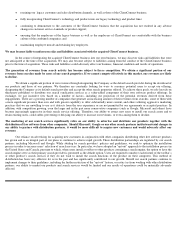Incredimail 2013 Annual Report Download - page 20
Download and view the complete annual report
Please find page 20 of the 2013 Incredimail annual report below. You can navigate through the pages in the report by either clicking on the pages listed below, or by using the keyword search tool below to find specific information within the annual report.
The online advertising market is very concentrated, with search in general, and Google in particular, playing a substantial role in that
market, limiting our flexibility to operate in this market.
In 2013, online advertising continued to grow globally and in the United States in particular. Advertising through search accounted for
the largest portion of online advertising and in the United States accounted for approximately 40% of all money spent on online advertising.
Google as an advertising publisher accounted for most U.S. online ad revenues. This high market concentration causes us to be subject to
unilateral changes set by Google, with limited ability to respond to and adjust for those changes. Although we utilize other methods of
advertising and partnering with other companies, these are currently not as lucrative as search advertising in general and affiliation with Google
in particular. Continued unilateral changes could adversely affect our revenues and performance.
The acceptance of online advertising, particularly paid listings, as an effective alternative to more traditional advertising is limited and
heavily dependent on the continued commercial use of the Internet.
Many advertisers still have limited experience with online advertising and may continue to devote significant portions of their
advertising budgets to traditional advertising media. Accordingly, we continue to compete with traditional advertising media, including
television, radio and print, in addition to a multitude of websites with high levels of traffic and online advertising networks, for a share of
available advertising expenditures and expect to face continued competition as more emerging media and traditional offline media companies
enter the online advertising market. The continued growth and continued acceptance of online advertising generally is likely to depend, to a large
extent, on its perceived effectiveness and the acceptance of related advertising models (particularly in the case of models that incorporate user
targeting and/or utilize mobile devices), the continued growth in commercial use of the Internet (particularly outside of the United States), the
extent to which web browsers, software programs and/or other applications that limit or prevent advertising from being displayed become
commonplace and the extent to which the industry is able to effectively manage click fraud. Any lack of growth in the market for online
advertising, particularly for paid listings, or any decrease in the effectiveness and value of online advertising (whether due to the passage of laws
requiring additional disclosure and/or opt-
in policies for advertising that incorporates user targeting or other developments) would have an
adverse effect on our business, its financial condition and our results of operations.
Our business, and in particular, the portion of our business devoted to search-
monetization, is significantly reliant on the North
American market. Any material adverse change in that market could have a material adverse effect on our results of operations.
Our revenues have historically been concentrated within the North American market, accounting for 46% of our search-
monetization
based revenues for the year ended 2013. A significant reduction in the revenues generated by such market, whether as a result of a recession that
causes a reduction in advertising expenditures generally, or otherwise, which causes a decrease in our Microsoft or Google-
based North
American revenues could have a material adverse effect on our results of operations.
The browser extension and toolbar industry is susceptible to obsolescence with the continued advent of alternative Internet based
innovations which may become more attractive to users.
The development of new products and services in response to the evolving trends and technologies of the Internet, as well as the
identification of new business opportunities in this dynamic environment, requires significant time and resources. We may not be able to adapt
quickly enough (and/or in a cost-
effective manner) to these changes, appropriately time the introduction to the market of new applications and
features for our platform or for other products and services or identify new business opportunities in a timely manner. Also, these changes could
require us to modify related infrastructures, and the failure to do so could render our, or those of our partners, existing websites, applications,
services and proprietary technologies obsolete. The failure to respond to any of these changes appropriately (and/or in a cost effective manner)
could adversely affect us, our financial condition and our results of operations.
16
























